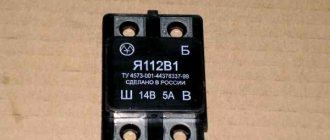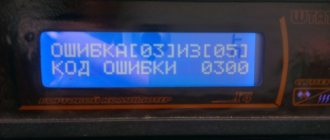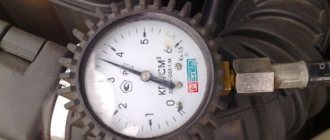Three-level voltage regulator
Hello everyone, today I will tell you about the “three-level voltage regulator”.
From the moment I bought the car, the voltage in the on-board network constantly sagged and sagged quite a bit, in the summer it was normal, but frost came, I changed the battery every two weeks, it was completely discharged.
It was decided to take a working bush generator, install it and drive it. We installed it, the result is a little better, but the voltage in the on-board network still drains, especially when the rear heating is turned on.
Then I started scratching my... turnip =) After climbing around D2, I saw that almost everyone suffers from such garbage and I saw “three saving words” - this is a “three-level voltage regulator” from.
Armed with a pen and paper, I began to call the entire city of Voronezh in search of “TRN”, but after calling 30-40 stores and hearing in almost every store “We have them, but they sell out very quickly,” I almost lost hope in the search.
But still…
I found it at the BB store and it was the last one. I picked it up from the window.
Having installed “TRN” all the problems disappeared, namely:
Now I have it on MAX showing 14.8-14.7 at Bright Light. heater on, music and rear window heating
The joints have disappeared:
— The alarm began to open well in the mornings, before it was cold when I had to open it with a ruler.
— The low and high beams began to shine brighter. — All the light bulbs in the cabin and outside began to shine brighter. — The stove is in the first position, almost blows away the driver and passengers =) — The windows have become faster. — In the morning it starts the first time. — The battery is always charged!
I advise everyone! Put it on for 5 minutes!
Voltage regulator for VAZ 2114: purpose, cost and replacement procedure
The vehicle's electrical system is extremely important for its proper operation.
Electricity works from the very beginning: when you turn the key in the ignition switch of a VAZ car, the electric starter turns the crankshaft for the first time. But a car is not a wall clock in which the battery can be changed once every few months; a car battery needs constant recharging. This function is performed by a direct current generator, which takes part of the power from the engine to perform its work. But, like any complex unit, it can give certain errors, but so that the voltage spread does not exceed 0.1 - 0.3 V and the generator always has an output within 13 V, a special VAZ voltage regulator is installed. Today we will understand what its purpose is, its structure and possible problems in the operation of the car due to the relay.
Voltage regulator VAZ (Three-level)
Generator
The generator is designed to generate electricity, which is so necessary for the stable operation of the vehicle's electrical equipment. Additionally, it performs the function of recharging the battery - with a discharged battery it will be impossible to start the engine. For the VAZ 2114 model, the nominal voltage of the electrical circuit is considered to be 12 Volts, but taking into account all consumers (lighting, ignition system, instruments, stove motor, windshield wiper motor, etc.) it should always be higher. Therefore, the voltage in the electrical circuit can range from 13.2 to 14.7 Volts. To maintain it at the required value, a regulator is installed in the generator circuit. Moreover, this device is present in any car, and not just on the 2114 model.
It is important for the car owner to know whether the generator produces the required current. Checking the functionality of the generator is primarily determined by the charging indicator located on the instrument panel inside the car. If the lamp lights up while the engine is running, then the generator circuit is faulty; diagnostics and, if necessary, repairs are required.
PURPOSE AND TECHNICAL DEVICE
The voltage regulator relay has a specific task - to stabilize the current in the vehicle’s on-board network at the same level. In his work, he takes into account the following factors:
- Load on the network (total electricity consumption of already switched on devices);
- Temperature around the car and in the engine compartment;
- Rotor speed of the generating device.
The voltage regulator of the VAZ 2114 generator is also required to monitor the voltage that comes out of the generator in order to maintain the normal operation of all devices, since disturbances in the electrical network can provoke inaccurate sensor readings, at a minimum. Technically, it works like this: in the event of noticeable disturbances, it constantly monitors the current on the battery, and at the right moment simply turns off or turns on the voltage that is fed into the excitation winding of the generator itself.
Voltage control and stabilization - operation of the regulator
Basic faults
The primary reason for the breakdown of generator brushes is their wear, which makes itself felt by a poor battery charge. You can detect a failed part by the following problems:
- voltage failures;
- the battery discharges quickly or does not charge at all;
- the headlights begin to burn much weaker or blink;
- instrument lights blink;
- There is not enough voltage for the electronics to operate and it turns off (radio tape recorder, for example).
POSSIBLE PROBLEMS
If problems arise with the generator, for example, if the on-board voltage of the VAZ 2114 is low, then possible faults should be sorted out in the following sequence:
- Mechanical damage to the relay terminals;
- Oxidation of contacts;
- Complete absence or poor contact between the generator housing and the vehicle’s ground.
Therefore, if you have problems with the regulator, then the first thing you need to pay attention to is this terminal, which goes to ground.
Voltages must only be measured with the ignition on, or you will fail.
To make a correct comparison, you first need to measure the voltage at the positive terminal of the battery; it should be the same as at the regulator ground.
By the way, all electronic regulators that were invented back in Soviet times were free of most of these shortcomings. Their design was somewhat more perfect, but they were forgotten at one time and later moved away from their production.
Replacing the VAZ 2114 generator
As mentioned above, the need to replace the 2114 generator can be caused by untimely troubleshooting of smaller components. However, there are other reasons that prompt drivers to think about replacing the generator set, for example: installing additional equipment in the car that consumes electricity.
Such power consumers include:
- powerful acoustic system;
- upgraded or additional outdoor lighting;
- additional lighting inside and outside the car.
When replacing a generator, many users give preference to a 115-amp device (from Priora and Kalina), installing it instead of the standard 80-amp one, which is provided for the VAZ 2114. In terms of fastenings, these devices are completely identical. The only thing that is required in this case is to replace the drive belt pulley.
To replace the 2114 generator, you should remove the device, following the instructions given earlier, and install a new one in its place (performing all steps in the reverse order of removal).
PRICE CATEGORIES
To find out the cost of a voltage regulator for a VAZ 2114, it is advisable to simply go to the nearest car market and ask, the price range may vary. This factor is influenced by the type of components and the region in which the store is located.
Typically, the price of a two-level standard regulator, which is installed at the factory in the VAZ 2114 and their families, can range from 300 to 1200 rubles, here the reason for the fluctuation depends on the quality and the specific manufacturer; more reliable and high-quality options will always be somewhat more expensive than their low-quality counterparts. As for three-level models, their price starts from 1,500 rubles, but their productivity is much greater. During the purchase, it is advisable to immediately ask the seller to check the functionality so that there are no problems in the future.
THREE-LEVEL REGULATOR
Replacing the regulator with a new one in the event of a serious breakdown on your own is quite simple, the main thing is to install the brushes correctly. This option is also very common when drivers deliberately choose a three-level VAZ 2114 voltage regulator for their car. Its installation must be carried out correctly; here it is important to correctly rearrange the generator protective casing and switch the contacts on the terminals. It may be better to initially seek help from specialists so as not to damage the entire generator. Technically, it differs from a typical relay in that it has a more efficient voltage regulator that maintains the voltage at a stable level at all times, even under rapidly changing conditions. The factory has not yet come to install such a regulator, since this option is considered more expensive.
Generator device
First you need to see the device of the VAZ 2114 generator.
All its parts are harmoniously located in a single housing, which is covered on all sides with protective covers. The base part of the housing also provides a base for the stator winding. No matter how massive the generator may seem, it is actually quite light, since most of the parts are made of light alloys, for example, duralumin. Since during operation of the generator it heats up quite strongly, special holes are provided in its housing for air cooling with a counter flow of air. In its front part, in the direction of travel, special rolling bearings are inserted on which the rotor rotates.
The connection diagram of the VAZ 2114 generator is such that from its output terminals the wires go to the battery, which ensures its recharging and energy storage. The generator will start working immediately after starting the engine, since the battery spends a significant part of the energy on turning on the starter and the first revolution of the crankshaft, the voltage on it drops to 9V and it must be recharged immediately.
REPLACING THE REGULATOR WITH A NEW OWNER ON YOUR OWN
Now we need to figure out how to replace the VAZ 2114 voltage regulator. First, you need to understand that it itself is located inside the generator housing. Mechanically, it consists of a special armature, an electromagnet and a relay. To disassemble the generator and remove the regulator we will need the following necessary tools:
- Set of open-end wrenches;
- Various screwdrivers.
Typically, repairs involve a complete replacement, but the generator itself does not need to be completely removed from the car. However, first you need to remember to remove the terminals from the battery, 12 V is not much, but it will be unpleasant to get hit. After the car has been de-energized, you need to remove the caps from the generator terminals and unscrew them with a screwdriver. Now you need to carefully remove the protective casing from the generator; on the VAZ 2114 it is equipped with spring latches; it is important not to break them right away. Now the voltage regulator of the VAZ 2114 generator will be visible under the casing; you need to unscrew its fastenings and pull it out of the seats along with the brushes.
The next phase of our work will be to check its functionality. Now let’s figure out how to understand that the voltage regulator is not working, for this we will need the following components:
- Accumulator battery;
- Miscellaneous wires;
- An ordinary 12 volt lamp, anything from the car's network will do.
You need to immediately understand that checking the regulator should be carried out only together with the brushes.
The light bulb itself must be connected via wires to the generator brushes; the polarity of the wires does not matter. Now you need to figure out where the negative terminal of the battery is and connect it to the relay body, and the second one must be connected to the regulator terminals. If everything is done correctly, the bright light from the light bulb will be a sure sign that all elements are working properly. You also need to know that testing the functionality of a new regulator is carried out in exactly the same way. After the repair is completed, everything must be assembled strictly in the reverse order, and it is advisable to charge the battery during the repair so that it does not lose its charge.
How to remove a generator on a VAZ 2114 on your own
The proposed option for removing the generator is convenient in that you do not have to remove the protection of the power unit. To perform all procedures, you will need tools such as wrenches (13 and 10), open-end wrench (17 x 19), socket (15) and a pry bar.
Next, the following steps are performed sequentially:
- The terminals are removed from the battery.
- The alternator belt is loosened and then completely removed.
- The belt tensioning mechanism is dismantled.
- The wires, which are covered with a rubber cover, are disconnected from the generator.
- The voltage supply connector to the voltage winding is disconnected.
- The generator is secured with a long nut and bolt, which is quite difficult to remove. First, you need to unscrew the bolts that secure the bracket to the block (using a 15mm socket). Then you need to rotate the device (direction clockwise), which will make it possible to remove the axis of attachment to the bracket. Now you can unscrew the nut with a 19mm wrench and pull it out along with the bushing.
- The axle is knocked out of the bracket using a punch.
Now you can remove the generator (up) and begin checking and servicing it.
Three-level voltage regulator for a car
Not long ago, I learned about a three-level voltage regulator and decided to install it on my car, since with a standard regulator, which is installed as standard, the battery is not fully charged, and you have to periodically recharge it from a charger.
Why do you need a voltage regulator?
The output voltage of the generator depends on the speed and current supplied to its rotor. If you connect power to the rotor and do not control it, then as the speed increases, the voltage at its output terminals can rise so much that all electrical consumers on the car burn out.
Since the engine speed varies over a wide range, the output voltage can only be controlled by changing the current in the rotor winding. This is exactly what a voltage regulator does. It monitors the voltage at the generator output and if it is higher than required, it reduces the pulse width supplied to the rotor winding, and vice versa increases the pulse width when the voltage decreases.
The standard voltage regulator (using the VAZ 2107 as an example) produces 13.6 volts. And if you turn on the load, it will sag and the battery will not be able to fully charge. It will need to be periodically recharged from a charger, otherwise its service life will decrease.
After starting the car, the battery needs to recover the energy it gave to the starter. To do this, the engine needs to run for a certain time. When the generator voltage decreases, this time increases. Therefore, when driving short distances from work to home, the battery cannot be restored.
Generator repair
Now we need to figure out how to quickly replace the generator brushes on a VAZ, how to remove the generator from the car and other relevant nuances. By the way, it should be noted that problems with the generator drive belt can also be the cause of all the troubles with the electrical equipment of the machine, which are described above.
A poorly tensioned belt, however, quickly manifests itself - it begins to squeal, especially when the car accelerates sharply. This is due to the belt slipping over the pulleys on the crankshaft and the unit. To check the tension, you can simply try to turn the belt; it should bend minimally. And if during the inspection you also find cracks, then the entire belt will have to be changed.











